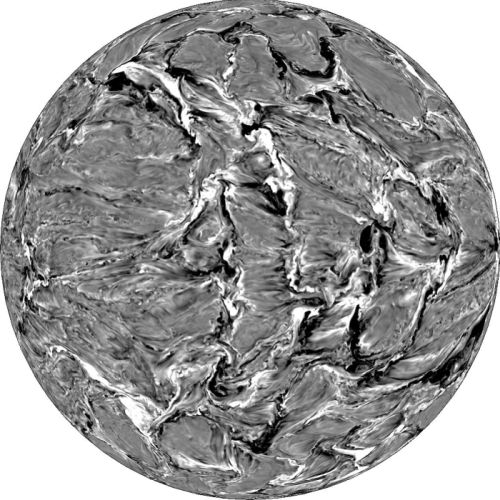An international team led by Hideyuki Hotta (Chiba University) in Group A04 of PSTEP revealed how large-scale ordered magnetic field in the solar convection zone is generated from high level chaos, using K-computer in Japan. The generated magnetic field is likely responsible for the 11-year solar cycle. This result is published in Science (25 March 2016, VOL. 351).
Magnetic field in upper part of convection zone reproduced using K-computer. (White and black colors show outward and inward directions of magnetic field, respectively)
1: Research Background
The sun has sunspots, which have strong magnetic field. Scientific observations using telescope were started by Galileo Galilei more than 400 years ago. According to the 400-year continuous observation of the sunspot, it is known that the number of sunspot varies with 11-year cycle period. However, the mechanism is still unknown, and it is one of the biggest mysteries in the solar physics. In addition, it is also known that there were only few sunspots during 1645-1715 (Maunder minimum). Studies indicate that the Earth was cooler in this duration. Therefore we need to investigate the mechanism of the solar 11-year cycle also in order to understand the long term variability of climate. It is one of the important subjects in our project PSTEP.
Solar convection zone is filled with turbulence which is thought to generate the magnetic field. Big mystery in 11-year cycle is the generation mechanism of the large-scale ordered magnetic field from small-scale chaotic turbulence.
2. Outcome – super high resolution calculation using K-computer –
A new method, the reduced speed of sound technique developed by Hotta’s group, enables us to carry out world highest resolution calculations. This super high resolution calculation reveals a generation mechanism for the large-scale magnetic field from the small-scale chaotic turbulence for the first time. In addition, 10 year scale cycle is also reproduced in the calculation. The result of the calculation shows that the small-scale magnetic field suppresses chaotic turbulence significantly and only ordered large-scale flows remain. This leads the construction of large-scale magnetic field.
The team will investigate the maintenance mechanism further mainly using the satellite observation and go toward to complete this 11-year cycle problem.
Research team
Chiba university, Hideyuki Hotta (PSTEP, Group A04)
High Altitude Observatory, Matthias Rempel
University of Tokyo, Takaaki Yokohama
Paper information
Journal:Science
Title:Large-scale magnetic fields at high Reynolds numbers in magnetohydrodynamic simulations Authors:H. Hotta, M. Rempel, T. Yokoyama
DOI:10.1126/science.aad1893
Link
Press release from Chiba university (only Japanese)
http://www.chiba-u.ac.jp/general/publicity/press/pdf/2015/20160324.pdf
Movies
http://www.astro.phys.s.chiba-u.ac.jp/~hotta/press/2016/index_e.html
Acknowledgement
The results were obtained by using the K computer at the RIKEN Advanced Institute for Computational Science (Proposal no. hp140212 and hp150226).
This work is supported Project for Solar-Terrestrial Environment Prediction (PSTEP).

